
Oman is making significant advances in expanding its role as a vital aviation gateway by launching new international flight routes aimed at boosting passenger traffic and invigorating its tourism industry. The Civil Aviation Authority (CAA) of Oman, in coordination with Oman Airports, has recently approved several key air services designed to strengthen connections with important international markets, underscoring the nation’s strategy to leverage aviation as a catalyst for economic development.
A notable highlight of these developments is the green light given to Russian carrier Red Wings Airlines to initiate a weekly nonstop flight between Muscat, Oman’s primary aviation hub, and Sochi, the famed resort city nestled along Russia’s Black Sea coast. Starting June twenty-second, this direct air link is set to facilitate easier travel for both leisure and business passengers, offering Russian tourists seamless access to Oman’s diverse attractions while providing Omani travelers a convenient gateway to Sochi’s picturesque landscapes and vibrant tourism offerings.
This new Muscat-Sochi connection represents a strategic expansion of Oman’s air network. Oman Airports has embraced this addition as part of a wider effort to diversify its international destination portfolio and nurture stronger global partnerships. By establishing direct service to Russia, Oman aims to enhance its appeal as a travel and transit destination, while promoting increased cross-border cooperation and economic exchange.
In parallel, Oman Airports announced the commencement of a direct flight route connecting Kannur, located in the southern Indian state of Kerala, with Muscat. Operated by the Indian low-cost carrier IndiGo, this thrice-weekly service launched recently and strengthens the enduring cultural, social, and economic bonds between Oman and southern India. The new route caters especially to the large expatriate community from Kerala residing in Oman, while also facilitating smoother travel for business and leisure visitors.
The Kannur-Muscat service exemplifies Oman’s targeted approach to enhancing connectivity with key South Asian markets. Direct flights reduce journey times and improve accessibility, anticipated to stimulate passenger growth and expand trade and tourism activities between the two regions.
Both the Sochi and Kannur routes are integral components of Oman Airports’ overarching vision to promote direct international connectivity as a driver for economic vitality and tourism expansion. Oman continues to forge collaborations with global carriers and broaden its route network to attract a wider spectrum of visitors and business travelers, cementing its status as a premier Middle Eastern aviation hub.
Despite these promising advancements, Oman’s aviation sector experienced a moderate decline in passenger volumes earlier this year. Official data reveals an 8.5 percent drop in passenger throughput in March 2025 compared to the previous year, with 3.54 million travelers passing through Omani airports versus 3.84 million in March 2024. This trend reflects broader global and regional challenges, including economic fluctuations and evolving travel preferences following the pandemic.
Muscat International Airport remains the busiest gateway, handling approximately 3.18 million passengers through March 2025. The airport continues to play a pivotal role in Oman’s vision of becoming a top-tier tourist destination and a key regional transit hub. Ongoing investments in infrastructure upgrades, customer service enhancements, and route expansion are poised to help reverse recent declines and foster future growth.
Looking forward, the introduction of these new international flight routes and the ongoing expansion of Oman’s air connectivity network position the country for sustained progress in aviation and tourism sectors. By establishing direct links with emerging and established markets such as Russia and southern India, Oman is broadening its appeal to diverse traveler segments—from cultural tourists seeking authentic experiences to business visitors engaged in regional commerce.
This strategic diversification also enhances Oman’s resilience by reducing reliance on a limited set of source markets, enabling the aviation sector to better adapt to shifting global travel dynamics. The focus on nurturing ties with key regions underscores Oman’s proactive stance in unlocking fresh economic opportunities.
In conclusion, Oman’s recent approvals for direct flights to Sochi and Kannur showcase its determination to expand its global air travel footprint, improve accessibility, and stimulate tourism and economic growth. While passenger numbers have recently faced some setbacks, the nation’s robust strategic initiatives and continued infrastructure investments signal a strong commitment to long-term development.
These endeavors reinforce Oman’s aspiration to be recognized not only as an attractive travel destination but also as a vibrant aviation hub linking the Middle East with Europe, Asia, and beyond. As new routes come online and international partnerships deepen, Oman is set to amplify its global presence and unlock expanded opportunities in travel, trade, and cultural exchange.
The post Oman, Russia, and India Strengthen Aviation Links with New Weekly Flights Between Muscat, Sochi, and Kannur Enhancing Passenger Traffic: Know More appeared first on Travel And Tour World.